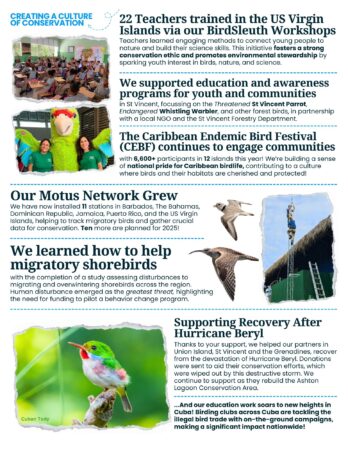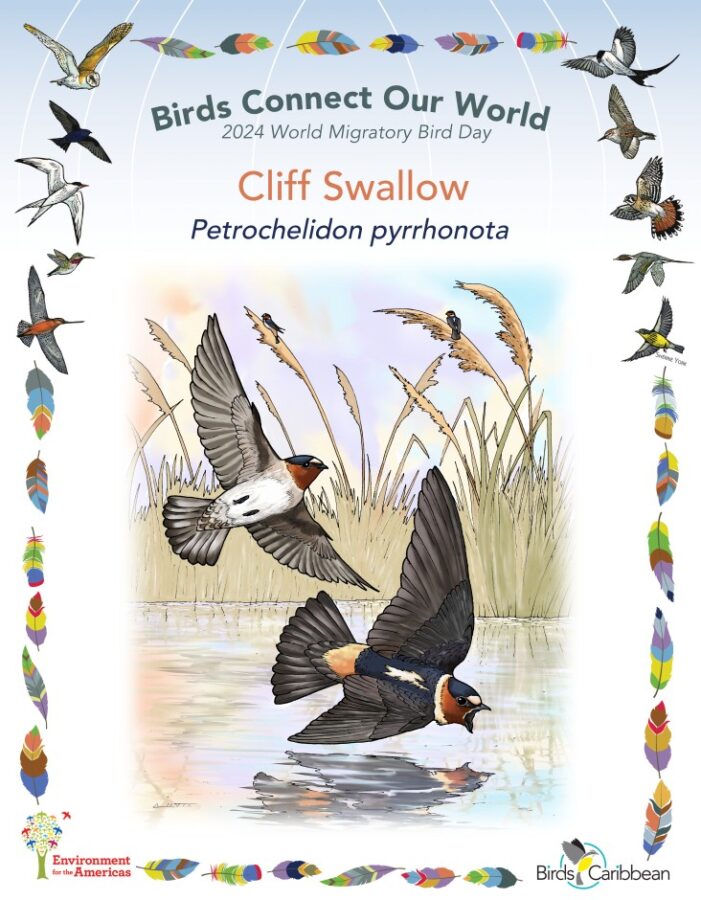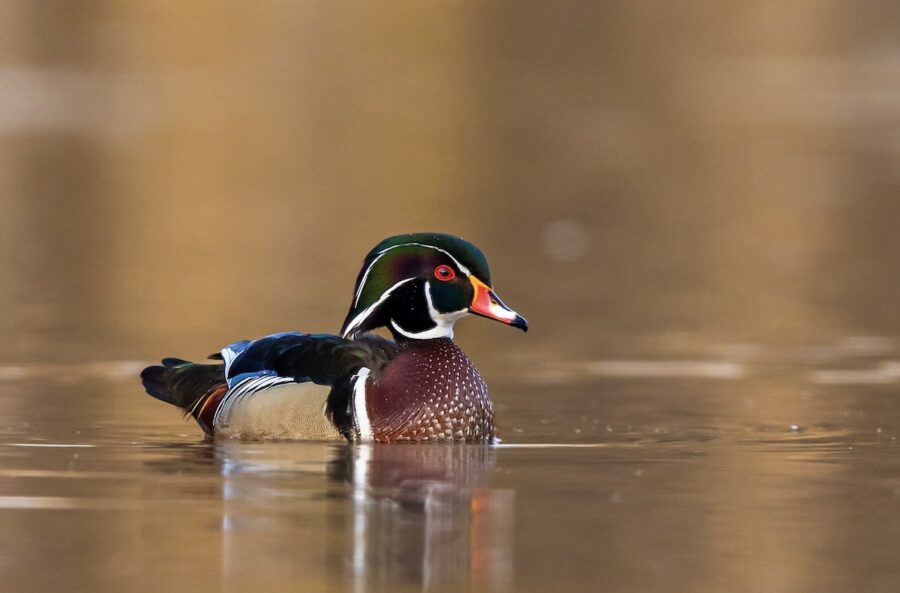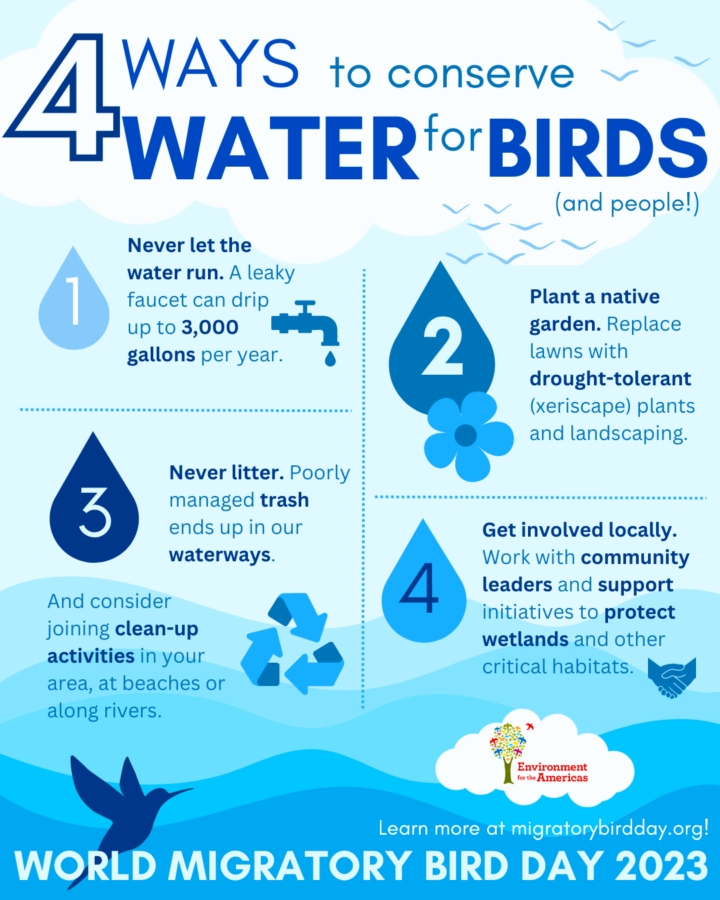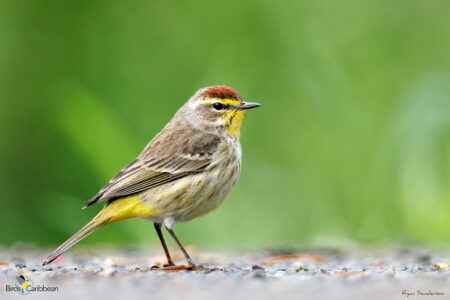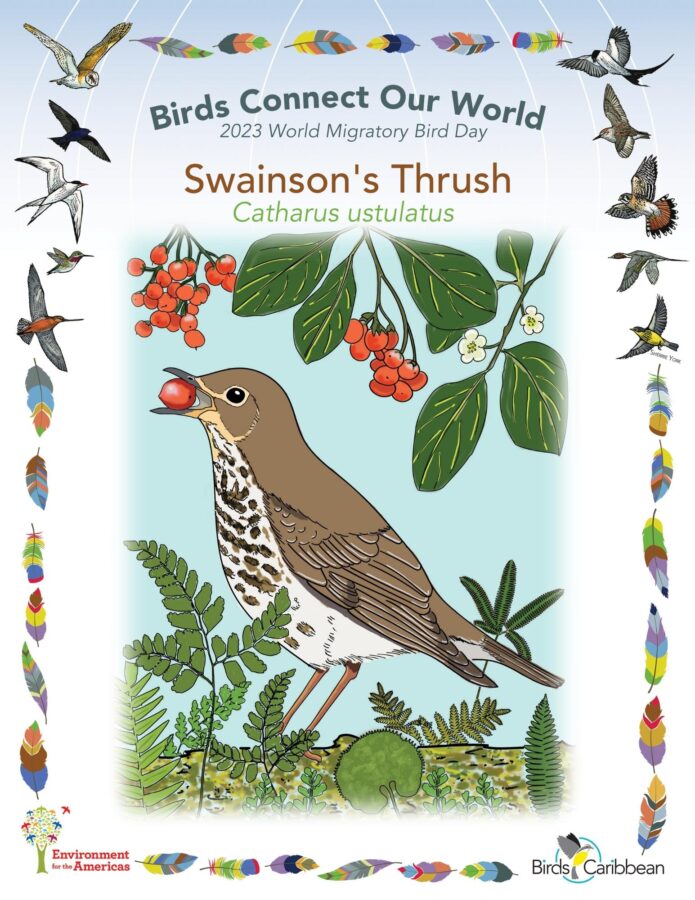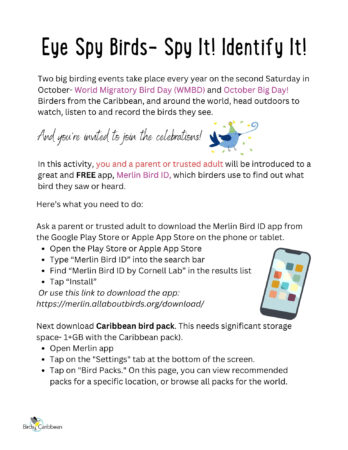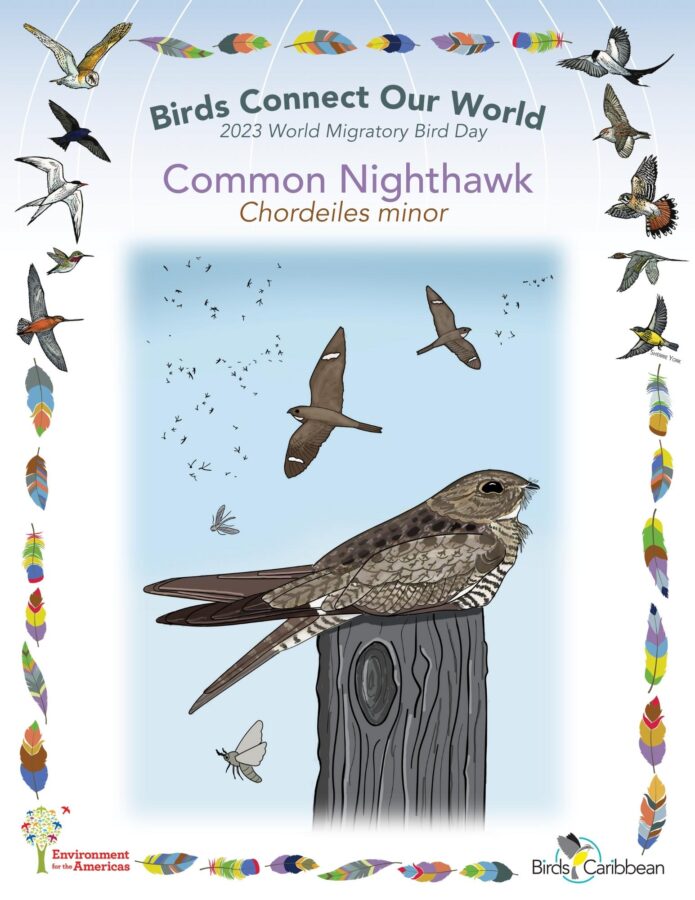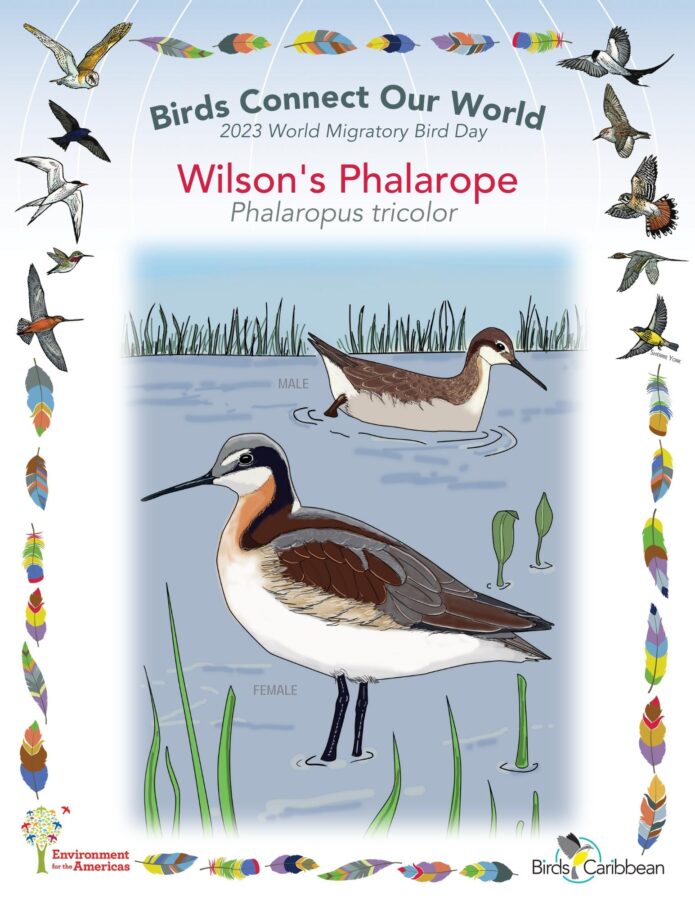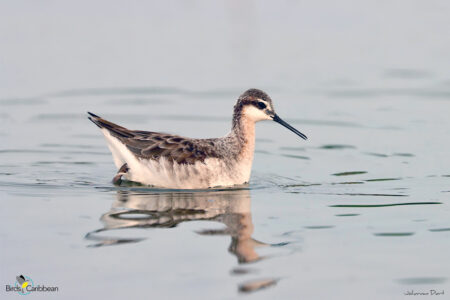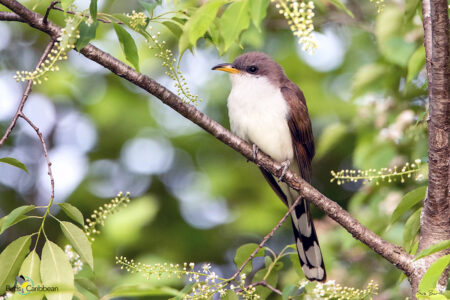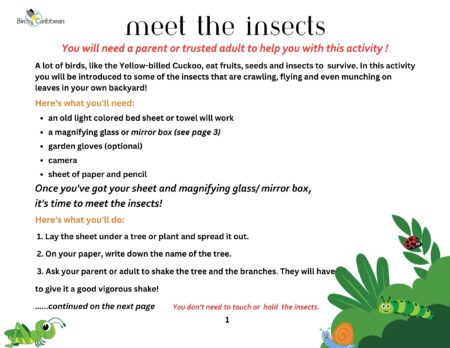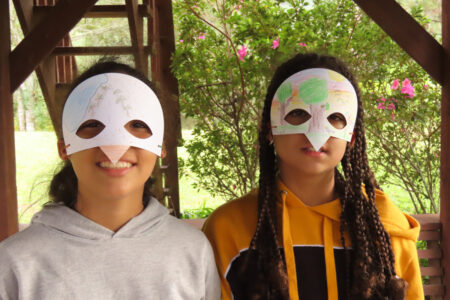Each year, thousands of migratory birds embark on epic journeys south—some fly non-stop to Central and South America, while others stopover or even spend the winter along the Caribbean’s sunny coastlines, wetlands, and forests. Throughout fall 2024, we celebrated these incredible travelers for World Migratory Bird Day (WMBD), and explored the surprising link between their survival and the health of insect populations. Read on to discover the creative ways Caribbean conservation organizations joined the celebration and why protecting insects is vital for the survival of migratory birds!

Welcoming Our Winged Travelers
WMBD in the Caribbean officially took place on October 12th, 2024, but migratory birds don’t all move at once. Some begin their journey south as early as August, leaving their nesting sites in Canada and the U.S. for wintering grounds in the Caribbean, Central, and South America. Every year, we eagerly await their arrival as they flock to our shores, wetlands, forests—and even our backyards! Across the Caribbean, celebrations often begin in September and extend through December.
This year’s theme, Protect Insects, Protect Birds, was especially timely, highlighting the urgent need to address the global decline in insect populations. In Spanish: Proteger a los insectos, proteger a las aves, and in French: Protégeons les insectes, protégeons les oiseaux.
Why Insects Matter
The 2024 WMBD theme came at a crucial time, as insect populations worldwide are plummeting due to pesticide use, habitat destruction, and climate change. Insects are a critical food source for migratory birds, providing the energy needed for their extraordinary journeys. In the Caribbean, with its tropical climate and rich insect life, protecting insects is essential for sustaining these long-distance travelers.

Unfortunately, insects face numerous threats, including habitat loss, pesticides, climate change, and bright artificial lights at night. For instance, artificial lighting disrupts fireflies’ mating behavior and caterpillars’ feeding patterns, while swarming around outdoor lights leaves insects exhausted and vulnerable to predators. This is bad news for migratory birds—without enough insects to fuel their journeys, birds can struggle to migrate, reproduce, and survive.

Simple Actions, Big Impact
The decline in insect populations is a significant threat to bird health, but the good news is we can all take simple steps to make a difference. Actions like planting native flowers, trees, and shrubs; supporting organic farming; preserving natural habitats; and leaving fallen leaves for insects can create healthier ecosystems for both bugs and birds.

Caribbean Communities in Action
Communities across the Caribbean came together to raise awareness about the critical role insects play in the survival of migratory birds and to inspire actions that make their environments more insect-friendly. Here are some highlights from this year’s WMBD events held in The Bahamas, Jamaica, US Virgin Islands, Dominican Republic, Puerto Rico, and Antigua and Barbuda.
The Bahamas
To celebrate WMBD, several educational events were held on Grand Bahama Island throughout October and November, engaging students in hands-on learning about birds, their migratory patterns, and the importance of protecting insects to protect birds.
Deana Williamson, a Social Studies teacher at Eight Mile Rock High School, led her students in exploring the connection between insects and birds. Students participated in an interactive activity, matching migratory birds with the insects they typically feed on, while discussing the variety of insects found on the island.
The celebration continued with EARTHCARE’s Bird Educator, Bridget Davis, and members, Jill Cooper and Gail Woon, visiting Bishop Michael Eldon School. Students learned about migratory bird species in The Bahamas and practiced birdwatching techniques using binoculars. Fun prizes like bird-themed bracelets and masks boosted engagement.
Later, Davis and Woon joined Mrs. Rochelle Manchester’s class at Martin Town Primary School for a birdwatching excursion. The students identified 13 bird species, including two rare American Oystercatchers spotted along the shoreline! Reflecting on the experience, Mrs Manchester shared, “The lesson has been the catalyst for a few of them doing their own research on migratory birds. It has truly sparked an interest for the students. I’d love to teach this again next year.”
Jamaica
BirdLife Jamaica marked WMBD with a muddy but exciting birdwatching event at the Old Harbour Mud Flats in St. Catherine—the third in a series focused on raising public awareness of shorebirds in Jamaica. The first two events were webinars on identifying shorebirds and where to find them, aptly titled ‘Shorebirds: The Beach Bums of the Bird World’ and ‘Birds of the Beach: A Beginner’s Guide to Shore Birding’, respectively.
Twenty enthusiastic birders braved the heat and muddy terrain to put their new shorebird ID skills to the test! The group recorded an impressive 37 species, with the Killdeer and Reddish Egret stealing the spotlight. The real surprise came with the sighting of a lone Black Swift—an uncommon find, as it prefers montane forested habitats, and a lifer for many of the newer birders!
US Virgin Islands
On WMBD, the St. Croix Sea Turtle Project and Sandy Point National Wildlife Refuge team led a 2-hour, 2-mile birdwatching hike at the refuge, spotting long-distance migrants like Ruddy Turnstones and small wading birds like Wilson’s Plovers. Ellie Sherman, Education and Outreach Officer for the Sea Turtle Project, shared that the small but enthusiastic group enjoyed exploring Sandy Point’s rich ecology and spotting birds in the refuge’s bird blind and along the beach. Fun fact: Sandy Point is where the rare White Tern was spotted in August 2024!

Dominican Republic
Maria Paulino and her team from Grupo Acción Ecológica (GAE) celebrated WMBD with classroom lessons and outdoor activities. Preschoolers were excited to learn about the migratory birds that travel thousands of miles every year to spend the winter in the Dominican Republic. Bursting with new inspiration, students then got creative, making bird masks and coloring migratory birds from the Migratory Birds of the West Indies book (free download available!).
Older students ventured outdoors for an introduction to bird banding. Maria took them through the process of setting up mist nets, collecting data on bird size and weight, and explaining how this information adds to our growing knowledge of what birds require to thrive. The highlight? Using binoculars and field guides to identify local birds!
Puerto Rico
The team at Centro Ambiental Santa Ana (CASA) embarked on an exciting adventure into Puerto Rico’s urban forest, joining students from the Universidad Interamericana – Recinto Metro for a hands-on research project: Exploring the Winged Diversity of Puerto Rico in an Urban Forest. This ongoing research aims to monitor both resident and migratory bird species through monthly counts, along with other activities in the vibrant Santa Ana Forest, located in the Julio Enrique Monagas National Park in Bayamón.
On WMBD, college students with no prior birding experience, but a strong passion for wildlife, kicked off their training to join the research team as bird monitors. After an introduction to the essentials of birdwatching led by Dayamiris Candelario, the group headed to the forest to hone their newly acquired skills . Among the species spotted, a thrilling moment came when they identified their first migratory bird—a male Northern Parula sporting the iconic chestnut “collar”.

The students continued their journey into the world of birding with training and fieldwork, beginning their official bird monitoring on October 24th and 26th. Their hard work paid off as they identified several fascinating species, including the Blackpoll Warbler and Black-and-white Warbler. They were delighted to spot more Northern Parulas foraging in the trees, perhaps hunting for their next bug meal.
“The project is just getting started, and with each field session, these budding birders are gaining valuable skills and contributing to the growing understanding of Puerto Rico’s dynamic bird population. We are incredibly grateful for the support and materials provided by Environment for the Americas and Departamento de Recursos Naturales y Ambientales (Department of Natural and Environmental Resources),” says Dayamiris.

Antigua and Barbuda
The Environmental Awareness Group (EAG), led field trips to explore wetlands and welcome migratory birds settling in for the winter. EAG staff journeyed to Darkwood Mangrove with students from Jennings Secondary and St. Mary’s Secondary, Parham Mangrove with Sir Novelle Richards Academy and Pares Secondary, and McKinnon’s Salt Pond with Antigua Girls’ High School and Antigua Grammar School.
The thrill of spotting birds in the wild was heightened as participants learned to use binoculars for the first time, with the stunning wetland setting providing the perfect backdrop. A fun game of Bird Spy Bingo added a competitive edge as attendees raced to identify as many species as possible.
EAG also brought bird-themed lessons to the classrooms at Antigua State College and St. Nicholas Primary School, sparking curiosity about migratory birds and their conservation. Students learned how actions like using organic pesticides and reducing waste can help protect birds and their habitats for future generations.
WMBD 2024’s Outstanding Educators
We applaud the tremendous efforts of all educators who plan and execute educational and fun activities to ensure an unforgettable WMBD and inspire a love for birds and birdwatching. For WMBD 2024, Environment for the Americas recognized the dedication of the following Caribbean educators: Justin Saunders (BirdLife Jamaica), Osmani Borrego Fernandez (Guanahacabibes National Park, Cuba), Jorge Brocca (SOH Conservacion, Dominican Republic), Achsah Mitchell (St. Eustatius National Park) and Devon Carter (Anguilla National Trust). We are also deeply grateful for the ambassadors, who selflessly deliver WMBD educational materials called ‘Happy Kits’ to Caribbean coordinators.
Environment for the Americas and BirdsCaribbean extend our greatest thanks to all of you and we look forward to seeing what you have planned for WMBD 2025!
Interested in supporting bird festivals across the Caribbean? Your contribution will help expand these invaluable efforts and inspire future generations of bird enthusiasts. Show your support here!
Birds Continue to Connect our world
BirdsCaribbean celebrated WMBD by showcasing new migratory birds in our virtual campaign– Birds Connect Our World. Each bird profile was accompanied by a beautifully drawn image by Arnaldo Toledo, along with stunning high-quality photos, engaging videos, online puzzles tailored for different levels (between six and 1,024 pieces), and bird calls. Fun, free and engaging activities were also provided for both kids and adults, including downloadable coloring pages, experiments, up-cycle crafts, and more.
Migratory Birds in Focus
We’re excited to announce the winning photo for the Caribbean region – Youth category in the 2024 World Migratory Bird Day Photo Contest! Captured by Mattéo Antoine, this striking image of a Semipalmated Sandpiper feeding on Ephydra flies at Pointe des Châteaux, Saint-François, Guadeloupe highlights the critical importance of healthy insect populations for migratory birds, especially those traveling thousands of miles nonstop.
Looking Ahead to 2025: Shared Spaces
The theme for WMBD 2025, Shared Spaces: Creating Bird-Friendly Cities and Communities, will focus on the importance of building urban environments that support both people and wildlife. As cities continue to grow, it’s crucial that we create spaces where birds can thrive—whether through green rooftops, bird-friendly architecture, or protected green areas. By incorporating bird-friendly practices into our daily lives and communities, we can help ensure that migratory birds have safe spaces to rest, feed, and thrive as they journey across the islands.

If you are interested in celebrating WMBD in your country, or if you can deliver materials to a Caribbean country, we encourage you to visit the WMBD website for more information; or contact the Caribbean Regional Coordinator, Laura Baboolal, at lbaboolal@environmentamericas.org.










































































